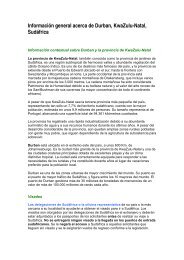You also want an ePaper? Increase the reach of your titles
YUMPU automatically turns print PDFs into web optimized ePapers that Google loves.
J<br />
ellyfish are members of the phylum Cnidaria<br />
which include corals, anemones and<br />
bluebottles. Jellyfish are typically bell-shaped,<br />
fringed with stinging tentacles. The adult stage is<br />
called a medusa after the unfortunate woman of<br />
Greek mythology who was loved by the god of the<br />
sea and as a result had her hair changed into snakes<br />
by a jealous goddess. Jellyfish are transparent and<br />
constructed of two layers of cells separated by a<br />
jelly-like mesogloea that gives the organism a<br />
degree of rigidity so that it can withstand the<br />
buffeting of the sea. The jelly layer is slightly lighter<br />
than seawater enabling the jellyfish to float in the<br />
sea. Jellyfish can swim by convulsive contraction<br />
of their bells but are largely at the mercy of ocean<br />
currents and frequently wash ashore after storms.<br />
They are an important food source for leatherback<br />
turtles, sunfish and beach dwelling scavengers<br />
such as plough snails and ghost crabs.<br />
Feeding and swimming<br />
Jellyfish swim by contracting and relaxing sets of muscles at the<br />
margin of the bell. Contraction of the muscles tightens the<br />
bottom of the bell, like pulling the drawstrings on a bag. This<br />
forces water out through the bottom of the bell, and jets the<br />
jellyfish forward. Relaxing the muscles opens the bell again,<br />
adult medusa phase<br />
balancing organ<br />
tentacle<br />
frilly ‘arms’<br />
around mouth<br />
C O A S TA L A N D M A R I N E L I F E – A N I M A L S : I N V E RT E B R A T E S – C N I D A R I A N S<br />
Jellyfish 3B<br />
preparing for another contraction. The pulsing of the bell is<br />
controlled by a simple nervous system, and eyespots (or<br />
complex eyes in the case of box jellyfish) allow the animal to<br />
respond to light. Many jellyfish display distinct phototaxis: they<br />
come to the surface of the water during cloudy weather and at<br />
twilight, and move downward in bright sunlight and at night.<br />
Some feed on the organic particles that float around them as<br />
they drift through the sea. Others capture small fish that blunder<br />
into them. Since food may come from any direction jellyfish are<br />
radially symmetrical with a ring of tentacles to intercept and<br />
convey the food to the central mouth. Most jellyfish belong to<br />
the order Semaeostomae and have bell-shaped medusae with<br />
a scalloped edge bearing numerous tentacles that catch the<br />
prey. The mouth is divided into four frilly, oral arms that open<br />
into a stomach with radial canals: a common example is the<br />
red-banded jellyfish, C h rysaora hysoscella. Jellyfish of the ord e r<br />
Rhizostomae do not have tentacles, and instead use their<br />
deeply-folded oral arms to capture tiny zooplankton. Rather<br />
than a single mouth, there are a number of small secondary<br />
mouths that open<br />
into the stomach by<br />
way of canals in the<br />
oral arms. A<br />
common<br />
example of this<br />
order is the root-<br />
mouthed j e l l y f i s h<br />
R h i z o s t o m a.<br />
Giants up to one<br />
Life cycle of red-banded jellyfish<br />
gonad<br />
egg<br />
stomach pouch<br />
metre in diameter often wash ashore.<br />
planula larva<br />
(2 mm)<br />
ephyra larva<br />
(3 mm)<br />
Root-mouthed jellyfish<br />
sedentary<br />
polyp-stage<br />
schystostoma<br />
larva<br />
buds off<br />
small mouths
















